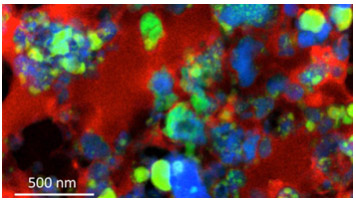
Scientific Achievement
A team of Foundry staff and users determined that samples of interplanetary particles from Earth’s upper atmosphere contain dust from the initial formation of the solar system.
Significance and Impact
This study is the first to confirm dust particles pre-dating the formation of our solar system. Further study of these materials will enable a deeper understanding of the processes that formed and have since altered them.
Research Details
- Using transmission electron microscopy at the Molecular Foundry, the research team made maps of the element distributions of tiny glassy grains derived from comets called GEMS (glass embedded with metal and sulfides) and discovered that they were made up of subgrains that aggregated together in a different environment prior to the formation of the comet.
- The types of carbon in these particles decompose with even weak heating, suggesting that the GEMS could not have formed in the hot inner solar nebula, and instead formed in a cold, radiation-rich environment, such as the outer solar nebula or pre-solar molecular cloud.
- Infrared spectroscopy at the ALS confirmed the presence of organic carbon and identified the coupling of carbon with nitrogen and oxygen, which confirmed the electron microscopy measurements.

